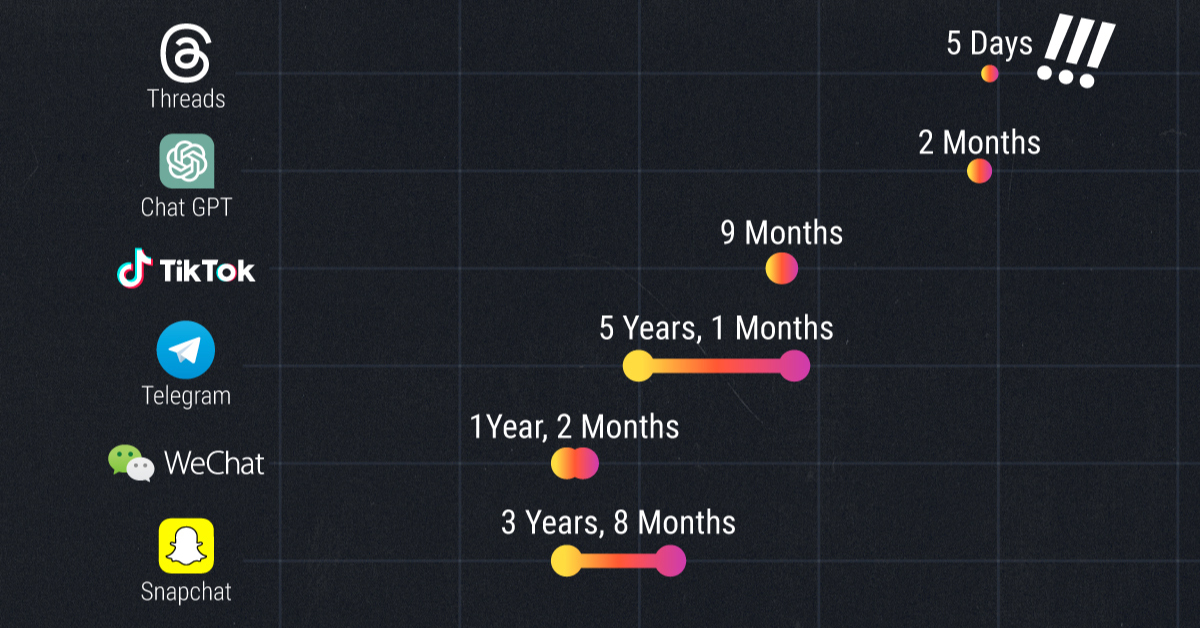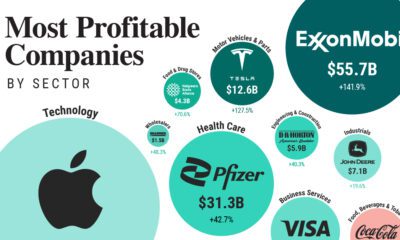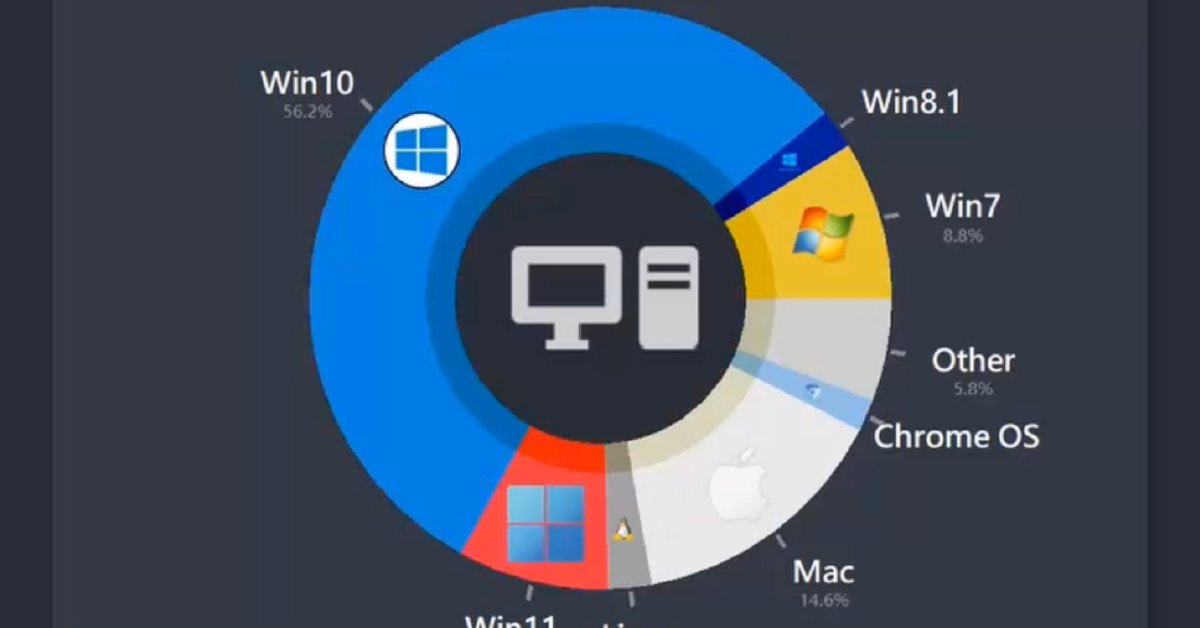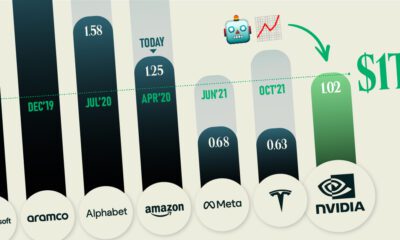Technology
Animated: Most Popular Desktop Operating Systems Since 2003
The Most Popular Desktop Operating Systems Since 2003
Mobile phones might be the most common way of getting online today, but the digital and internet era started for most people with the humble desktop computer.
And over the past 20 years, a long list of operating systems (OS) have been used to run the most popular desktop computers.
Sjoerd Tilmans has created an animated chart showing the rise and fall in market share of popular desktop operating systems over the period of May 2003 to June 2022, using data from W3Schools and GS Stat Counter.
Microsoft’s Monopoly on the Most Popular Desktop OS
The story of the desktop OS market is a story of Microsoft’s explosive growth and market dominance.
In the 1980s, the fledgling company signed a partnership with personal computer behemoth IBM. Microsoft would supply IBM with an operating system for its computers, MS-DOS, and receive a royalty for every computer sold.
Those royalties boosted Microsoft’s coffers. And its release of Windows—a more visual interface than DOS—helped them grab hold of the PC market. The late 1990s and early 2000s saw different versions of Windows capture the market:
- Windows 95:
The now famous toolbar and Start menu made their debut here. The version also would launch Internet Explorer, once the world’s most popular browser. - Windows 98:
An upgrade to ‘95 which supported more hardware like USBs and connecting more than one monitor.
- Windows XP:
XP quickly became a fan-favorite because of its stability, and a hit with both commercial and personal computer clients. Windows XP gained market share steadily upon release in 2001, quickly becoming the most popular desktop OS with a peak of 76% market share in 2007.
| Operating System | Peak Market Share | Year |
|---|---|---|
| Win 95 | 57.4% | 1998 |
| Win 98 | 17.2% | 1999 |
| Win XP | 76.1% | 2006 |
Microsoft doubled down on their next releases from the end of the 2000s to 2020, with some misses (Windows Vista) and some hits (Windows 10). Here’s a look at the most popular ones:
- Windows 7:
Released as the successor to the poorly received Windows Vista, it kept the same visual style (“Aero”) but greatly improved performance and stability from Vista’s benchmarks. In 2011, Windows 7 passed XP to become the most popular desktop OS. - Windows 8 and 8.1:
Created for tablet-desktop integration, just as Microsoft released the companion Surface tablet. The beloved Start menu was replaced (an unpopular decision) and tile-based visual style introduced. However the dramatic differences between the desktop and tablet versions made for a steep learning curve, with the 8.1 release reintroducing the Start button. - Windows 10:
The follow-up to Windows 8 kept the the tile-based appearance but focused on a desktop-oriented interface with quality of life updates. By 2018, Windows 10 had become the most popular desktop OS, eventually peaking at 61% market share at the start of 2022.
| Date | Peak Market Share | Year |
|---|---|---|
| Win 7 | 55.1% | 2014 |
| Win 8 | 8.1% | 2013 |
| Win 8.1 | 16.8% | 2015 |
| Win 10 | 61.2% | 2022 |
The most recent version of Windows released, Windows 11, had updated graphics styling, widget integration, and introduced Microsoft’s latest internet browser Microsoft Edge. But it received a mixed response and slow uptake compared to Windows 10, gaining a market share of 8.3% by June 2022.
Microsoft Vs. Other Desktop OS Contenders
As of February 2023, Microsoft had a comfortable lead in the desktop OS market, holding nearly 72% of the market.
| Company | OS Name | Feb, 2023 Market Share |
|---|---|---|
| Microsoft | Windows | 72.0% |
| Apple | macOS | 16.3% |
| OpenSource | Linux | 2.9% |
| ChromeOS | 2.9% | |
| Unknown | Unknown | 6.0% |
In a distant second is Apple’s macOS. The most profitable company in the world might make most of their money from smartphones, but Apple has still managed to carve out a small but sturdy segment of the desktop operating OS market. It reached its peak of 19% in April 2020.
The other tech giant in the desktop OS game is Alphabet, whose ChromeOS is unique for using an internet browser (Google Chrome browser) as its primary interface. Generally packaged as a simpler and cheaper device option—it was primarily released with inexpensive laptops called “Chromebooks”. More recently, Alphabet announced a version that can be installed on existing computer hardware in 2022.
Compared to the commercially released OS above, Linux is completely free to download and use, and is the largest open-source software project in the world. Although the OS is only used in about 3% of desktop computers, it was also the basis of Android and ChromeOS, and is the most-used OS on devices with embedded software—routers, smart home devices, cars, and even a few spacecraft (The SpaceX Falcon 9, for example).

This article was published as a part of Visual Capitalist's Creator Program, which features data-driven visuals from some of our favorite Creators around the world.
apps
How Long it Took for Popular Apps to Reach 100 Million Users
Threads reached 100 million users in just five days. Here is a timeline of how long other popular platforms took to reach the milestone.

How Long it Took for Popular Apps to Reach 100 Million Users
Of Twitter’s many new rivals, Meta’s newest social media platform Threads has established its presence with a bang.
According to Meta founder Mark Zuckerberg, Threads took only 5 days to reach the key threshold of 100 million users. It achieved this milestone through organic demand—and no paid promotions required—smashing all previous records.
But how long have other popular platforms—TikTok, Instagram, and YouTube to name a few—taken to build their user base? Pulling data from PwC and Yahoo, we rank how long it took popular platforms to get to 100 million users.
Ranking Every Apps Journey to 100 Million Users
In first place, Threads has a significant lead over the rest of the pack with its five day achievement, and may have built a significant moat in holding on to this record.
Firstly, its launch coincided with Twitter’s viewing limit decision, and rode the wave of dissatisfaction aimed at Twitter’s current owner, Elon Musk.
Secondly, new users on Threads need an Instagram account to register, thus eliminating sign-up barriers and leveraging Instagram’s 1.2 billion-strong user base.
Here’s the journey length of popular platforms to attaining 100 million users:
| Rank | Platform | Launch | Time to 100M Users |
|---|---|---|---|
| 1 | Threads | 2023 | 5 days |
| 2 | ChatGPT | 2022 | 2 months |
| 3 | TikTok | 2017 | 9 months |
| 4 | 2011 | 1 year, 2 months | |
| 5 | 2010 | 2 years, 6 months | |
| 6 | Myspace | 2003 | 3 years |
| 7 | 2009 | 3 years, 6 months | |
| 8 | Snapchat | 2011 | 3 years, 8 months |
| 9 | YouTube | 2005 | 4 years, 1 month |
| 10 | 2004 | 4 years, 6 months | |
| 11 | Spotify | 2006 | 4 years, 7 months |
| 12 | Telegram | 2013 | 5 years, 1 month |
| 13 | 2006 | 5 years, 5 months | |
| 14 | Uber | 2011 | 5 years, 10 months |
| 15 | 2010 | 5 years, 11 months | |
| 16 | Google Translate | 2006 | 6 years, 6 months |
| 17 | World Wide Web | 1991 | 7 years |
| 18 | 2003 | 7 years, 11 months |
Ranked second, Open AI’s ChatGPT launched in November 2022 and hit 100 million users by the start of the new year. ChatGPT introduced the incredible capabilities of large language models to the masses, prompting a rush of sign-ups, and reviving old conversations around the potential consequences of AI.
Coming in at third place, ByteDance’s TikTok took just 9 months to reach 100 million users after its launch in 2017. Like Threads, TikTok benefited from another app, accessing popular lip syncing app Musical.ly’s existing user base after it was acquired and folded into TikTok.
WeChat and Instagram round out the top-five, also with interesting advantages. WeChat, an instant messaging platform similar to WhatsApp, benefited from its unique access to China’s notoriously closed internet market of 500 million users in 2012.
Meanwhile, Meta acquired Instagram when the photo-sharing platform had 30 million users, and more than tripled that number past 100 million in just one year.
And while Facebook ranks solidly middle-of-the-pack for fastest to 100 million users, it remains the platform with the most monthly active accounts, at nearly 3 billion. In fact, Meta’s lessons learned from Facebook have been well-leveraged, and the company owns 4 of the fastest apps to register 100 million users.
So What Does Threads Success Mean for Twitter?
Coming back to Threads’ incredible feat, however, it’s still early days whether an en-masse switch from Twitter is on the cards for Meta’s newest platform.
For one, Threads has faced significant criticism due to its intensive data collection practices and lack of accessibility features. It also is missing some key features from its rival, including trending topics, hashtags, and direct messages.
Meanwhile Elon Musk has been less than pleased with Threads’ success, deeming it a copy of Twitter and even threatening legal action.
Competition is fine, cheating is not
— Elon Musk (@elonmusk) July 6, 2023
So where does this leave the increasingly-crowded social media space? The next decade will set the stage for either more platform consolidation, or even further audience fragmentation.
-

 Markets2 weeks ago
Markets2 weeks agoRanked: The Most Profitable U.S. Companies, by Sector
-

 apps5 days ago
apps5 days agoHow Long it Took for Popular Apps to Reach 100 Million Users
-

 Markets4 weeks ago
Markets4 weeks agoThe World’s Biggest Mutual Fund and ETF Providers
-

 Brands2 weeks ago
Brands2 weeks agoBrand Reputations: Ranking the Best and Worst in 2023
-

 Green5 days ago
Green5 days agoHotter Than Ever: 2023 Sets New Global Temperature Records
-

 Datastream4 weeks ago
Datastream4 weeks agoCan You Calculate Your Daily Carbon Footprint?
-

 Energy2 weeks ago
Energy2 weeks agoWho’s Still Buying Russian Fossil Fuels in 2023?
-

 VC+4 days ago
VC+4 days agoWhat’s New on VC+ in July













